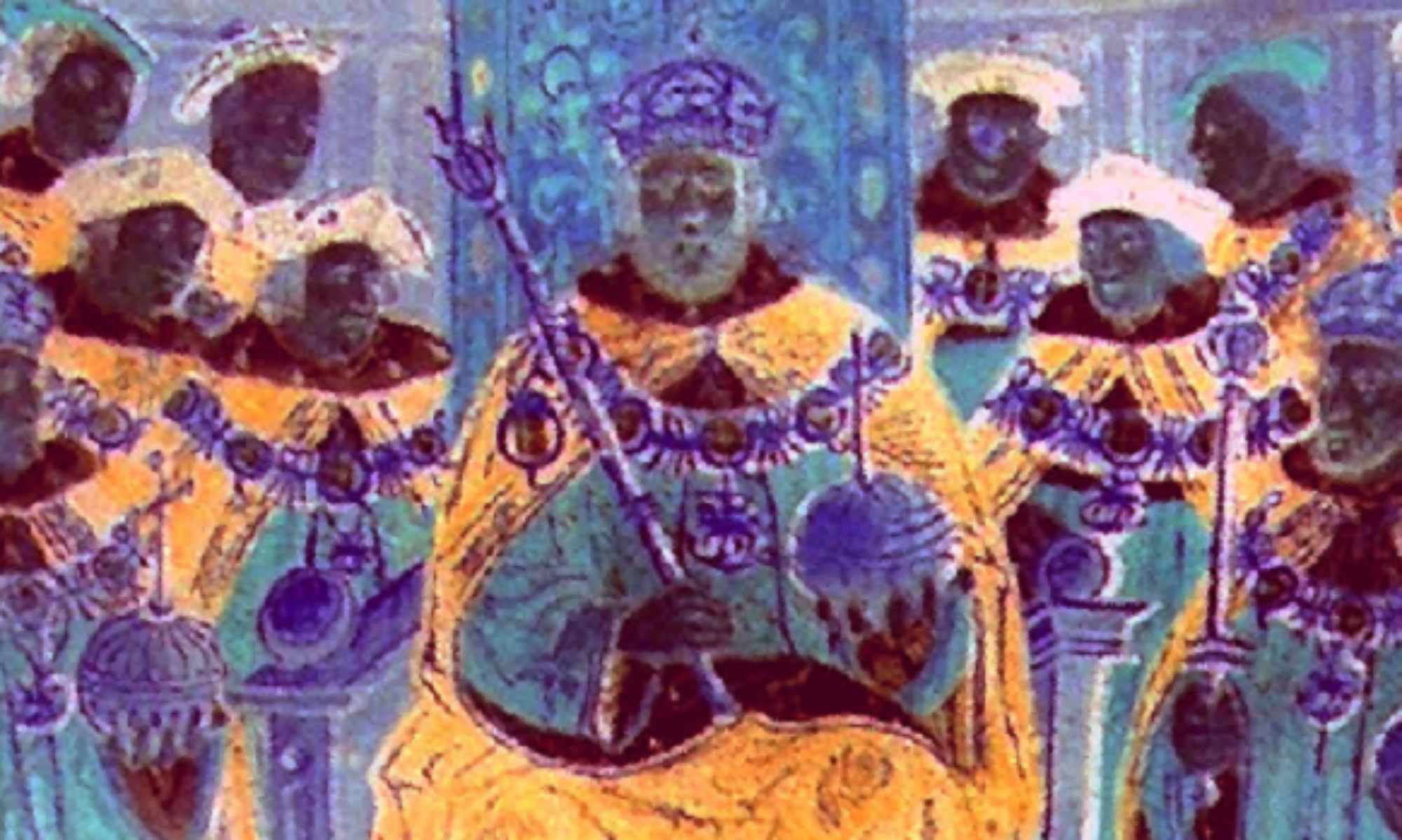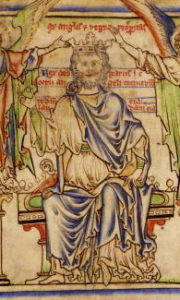 KING EDGAR THE PEACEFUL (Reigned 959 – 975)
KING EDGAR THE PEACEFUL (Reigned 959 – 975)
King Edgars coronation delayed until 973 (at Bath). Refer to our post on British coronation origins. Ælfthryth, Edgars wife was also crowned and anointed, granting her a status higher than any recent queen. She was the only Anglo-Saxon Queen Consort who is known to have had a coronation. The next wasn’t until After William the Conqueror came to the throne.
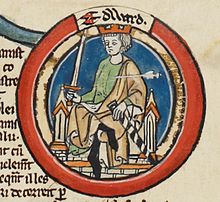 EDWARD THE MARTYR (Reigned 975 – 978)
EDWARD THE MARTYR (Reigned 975 – 978)
King Edgars will named his elder son, Edward, (Eadweard) as his heir and he had the support of the influential but now aged St. Dunstan, Archbishop of Canterbury. Many of the nobility of the realm, including the powerful Alfere, Ealdorman of Mercia were in favour of the seven year old younger half brother Ethelred succeeding, as they themselves had much to gain from the crown being subjected to a long minority government. The nation was divided over the issue of which of his sons should suceed King Edgar. A meeting of the witan was arranged at Calne, in Wiltshire were the matter was debated at length. Eventually, the influence of Dunstan prevailed and accordingly Edward was elected King. He ascended to the throne on July 8, 975.
Edward was crowned by St. Dunstan at Kingston upon Thames after July in 975, at the age of thirteen.
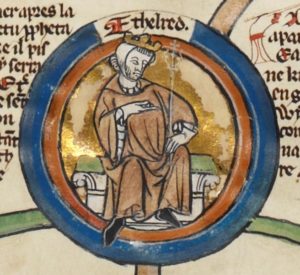 AETHELRED (Ethelred) II THE UNREADY (Reigned 978 – 1016)
AETHELRED (Ethelred) II THE UNREADY (Reigned 978 – 1016)
Aethelred became king on March 18, 978 on the murder of his half-brother, Edward the Martyr.
He was crowned by Dunstan, Archbishop of Canterbury on April, 978 at Kingston-upon-Thames, aged c.10.
The archbishop on the day of his coronation is said to have prophesied evil concerning him because he came to the throne through the murder of his brother. More likely Dunstan exacted a pledge of good government from him, and delivered an exhortation on the duties of a Christian king.
The coronation oath of Aethelred:
“In the name of the Holy Trinity, three things do I promise to this Christian people, my subjects; first, that I will hold God’s church and all the Christian people of my realm in true peace; second, that I will forbid all rapine and injustice to men of all conditions; third, that I promise and enjoin justice and mercy in all judgments, in order that a just and merciful God may give us all His eternal favour, who liveth and reigneth.”
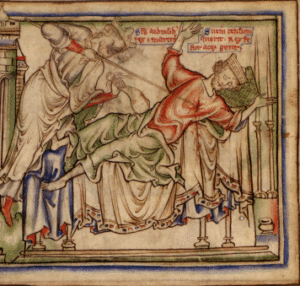 SWEYN FORKBEARD (Reigned 1013–1014)
SWEYN FORKBEARD (Reigned 1013–1014)
Aethelred reign was interrupted when Sweyn Forkbeard (Danish King/Viking) was pronounced King of England on Christmas Day 1013 and made his capital at Gainsborough, Lincolnshire. Sweyn died just 5 weeks later. He never had a coronation.
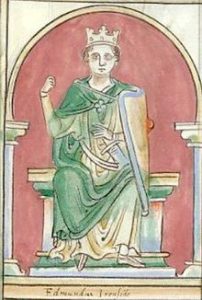 EDMUND II IRONSIDE (Reigned 1016 – 1016)
EDMUND II IRONSIDE (Reigned 1016 – 1016)
Following the death of his father Aethelred, Edmund ascended to the throne on April 23, 1016. He was chosen king by the inhabitants of London. The Witan (the king’s council) however elected the Viking, Canute (son of Sweyn). Edmund was crowned on 25 April, 1016 at Old St Paul’s Cathedral, aged c.26. Following his defeat at the Battle of Assandun (October 18, 1016), Aethelred made a pact with Canute to divide the kingdom between them. Edmund died later that year on 30 November 1016, either from battle injuries or possibly assassinated.
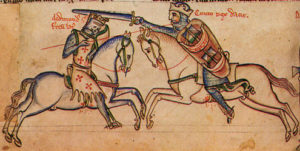
CANUTE (CNUT THE GREAT) THE DANE (Reigned 1016 – 1035)
Canute became king of all England following the death of Edmund II. His coronation took place in January, 1017 at Old St Paul’s Cathedral, aged c.22.
 HAROLD I (Reigned 1035 – 1040)
HAROLD I (Reigned 1035 – 1040)
Harold Harefoot was the illegitimate son of Canute. He claimed the English crown on the death of his father whilst his half-brother Harthacnut, the rightful heir, was in Denmark fighting to protect his Danish kingdom. However, Harold failed to sway Æthelnoth, Archbishop of Canterbury, who refused to crown him.
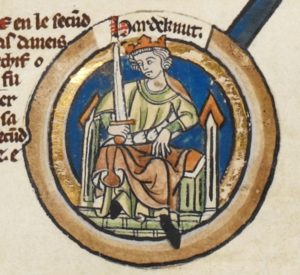 HARTHACNUT (Reigned 1040 – 1042)
HARTHACNUT (Reigned 1040 – 1042)
He was the son of King Cnut the Great and became King of England on 17th March 1040 on the death of his half-brother Harold Harefoot. His coronation took place on June 1040 at Canterbury. Harthacnut was the last Danish King to rule Britain.
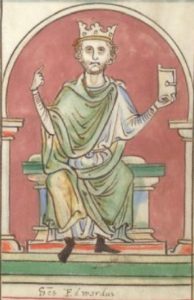 EDWARD THE CONFESSOR (Reigned 1042 –1066)
EDWARD THE CONFESSOR (Reigned 1042 –1066)
The son of Æthelred the Unready and Emma of Normandy, Edward succeeded his half brother Harthacnut. After returning from exile in France Edward he was crowned on 3 April 1043 at Winchester Cathedral, the royal seat of the West Saxons. Edith, his wife, had her own coronation as consort.
Edward the Confessor deposited his Royal ornaments for safe-keeping in Westminster Abbey and may have been the first monarch to assemble a regalia. These have been replaced or altered over the succeeding centuries.
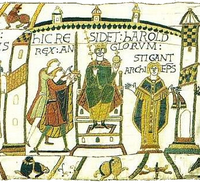 HAROLD GODWINSON (Reigned Jan-Oct 1066)
HAROLD GODWINSON (Reigned Jan-Oct 1066)
On the death of Edward the Confessor, the Witenagemot or kings council selected Harold to succeed. Harold’s coronation took place on 6 January 1066. The coronation was probably held in Westminster Abbey. He was the last Anglo-Saxon king of England.
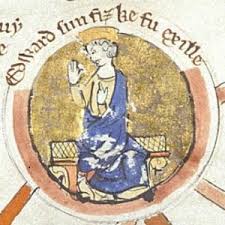 EDGAR ÆTHELING (Reigned Oct – Dec 1066)
EDGAR ÆTHELING (Reigned Oct – Dec 1066)
Edgar was the last male member of the royal house of Cerdic of Wessex. He was the son of Edward the Exile, who was the son of King Edmund II Ironside. Following Harold’s death at the Battle of Hastings against the invading Normans in October, the Witenagemot assembled in London and elected Edgar king. He was proclaimed, but never crowned King of England in 1066. The young uncrowned king ended up submitting to William the Conqueror and the Normans.
